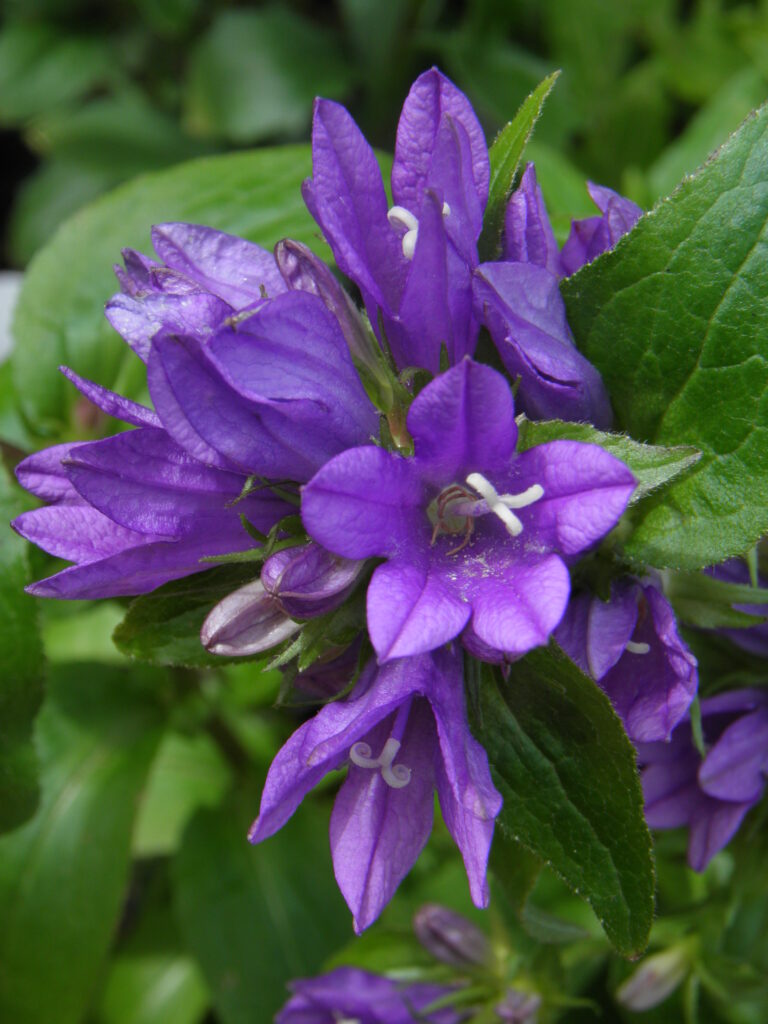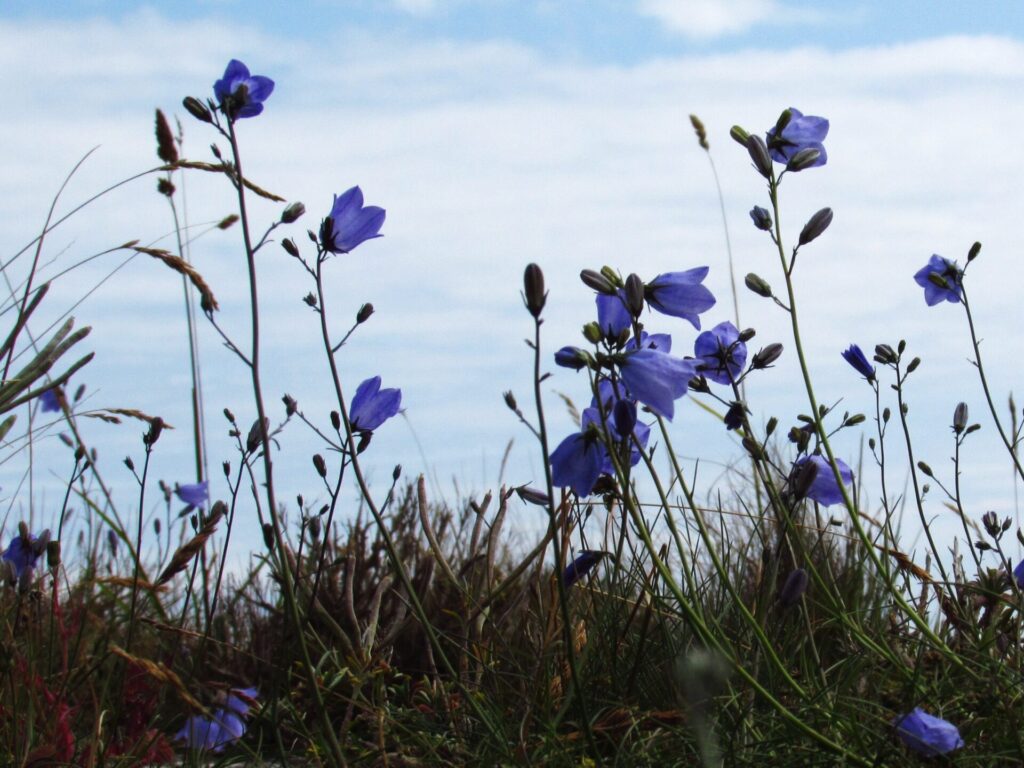
The Campanulaceae or Bellflower family is another family with many useful ornamental garden varieties but also has several native species in the main genus Campanula as well as in the genera: Legousia, Wahlenbergia, Phyteuma, Jasione and Lobelia.
The Campanulaceae are now in Family 133 according to Stace in between the interesting Lentibulariaceae or Bladderwort family and the Aquifoliaceae or Holly family!
See on the next page for all the main species in this family and about their ethnobotanical uses. This blog cannot provide all the info, such as where you can find them, what soil conditions, etc. But this is why I provide the links of some other marvelous websites out there! Green background is for the usual Edible or Wildlife uses and pink background for Medicinal uses. Blue background for where it grows in the B.I. (from PlantAtlas 2020) and ‘Interesting facts’ , although I hope you find all my information interesting!
Contents:
Campanula spp. or Bellflowers
There are 5 native species (number 1-5) and 4 introduced/garden escapes which are often much more abundant than the native species.
1) C. patula or Spreading Bellflower
C. rapunculus or Rampion Bellflower
C. persicifolia or Peach-leaved Bellflower
2) C. glomerata or Clustered Bellflower
C.portenschlagiana or Adria Bellflower
C.poscharskyana or Trailing Bellflower
3) C. latifolia or Giant Bellflower
4) C. trachelium or Nettle-leaved Bellflower
5) C. rotundifolia or Harebell
C. garganica or Adriatic Bellflower
Other genera and species:
Legousia hybrida or Venus’s-looking-glass
Wahlenbergia hederacea or Ivy-leaved Bellflower
Phyteuma spicatum or Spiked Rampion
Phyteuma orbiculare or Round-headed Rampion
Jasione montana or Sheep’s-bit
Lobelia urens or Heath Lobelia
Lobelia dortmanna or Water Lobelia
Pratia angulata or Lawn Lobelia
Pratia pedunculata or Blue Star Creeper
Campanula spp. or Bellflowers
There are 18 different species listed in Plant Atlas 2020 but only 5 are truly native, whilst the remaining are garden escapes.
These garden escapes are often so much ‘at home’ here, even more at home than many a native wildflower! All the campanulas produce abundant, small seeds which can germinate in small cracks on pavements and in walls and disturbed soils.
As many wildflowers they may be pollinated by beetles, flies, bees and butterflies; they have nectar/pollen rich flowers.
C. patula

Campanula patula or Spreading Bellflower
This is a native but decreasing in the wild.
A biennial herb of dry, well-drained, sunny sites on fairly infertile sandy or gravelly soils. It is found in open woodland, on banks and rock outcrops. Reproduction is by seed, which needs disturbed sites for germination, but which is long-lived, allowing the plant to reappear after long absences.
A bellflower weevil in the genus Miarus is associated with this plant.
C. rapunculus

Campanula rapunculus or Rampion Bellflower is not strictly a native. It was originally grown for its edibility and was recorded from the wild as early as 1597, but then it fell out of favour as a vegetable around 1700 and is now both rare in the wild as well as in cultivation.
- Root can be eaten raw or cooked. A very nice sweet flavour, reminiscent of walnuts. They are best mixed with other root vegetables and used in winter salads.
- Leaves – raw or cooked as a potherb. A fairly bland flavour, with a hint of sweetness, they are quite acceptable raw in salads. The leaves are rich in vitamin C, they make an acceptable winter salad.
- Young shoots in spring can be blanched and cooked like asparagus.
C. persicifolia
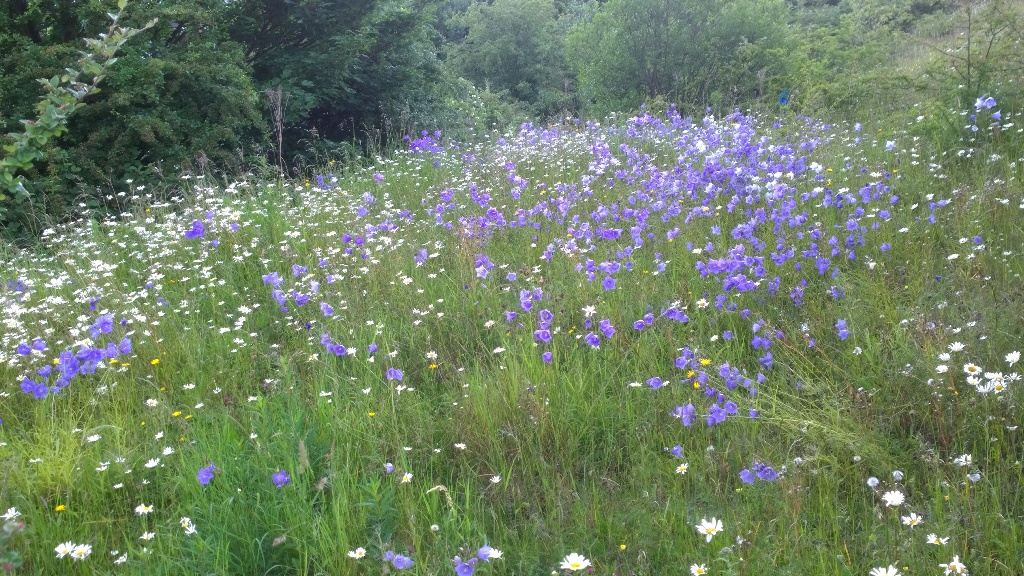
Campanula persicifolia or Peach-leaved Bellflower is a rhizomatous perennial herb found on waste ground, waysides and banks, and in hedgerows and woods. It is commonly cultivated, and occurs as a casual or, more frequently, as established and persistent populations.
C. glomerata
Campanula glomerata or Clustered Bellflower
A perennial herb of calcareous grassland, scrub, open woodland, cliffs and sand dunes. It is most frequent on chalk and oolite, and curiously absent from apparently suitable habitat on other limestones and base-rich substrates. It also occurs as a garden escape on roadsides and waste ground.
It is a much loved ornamental plant and apparently it is the county flower of Rutland!
C. portenschlagiana
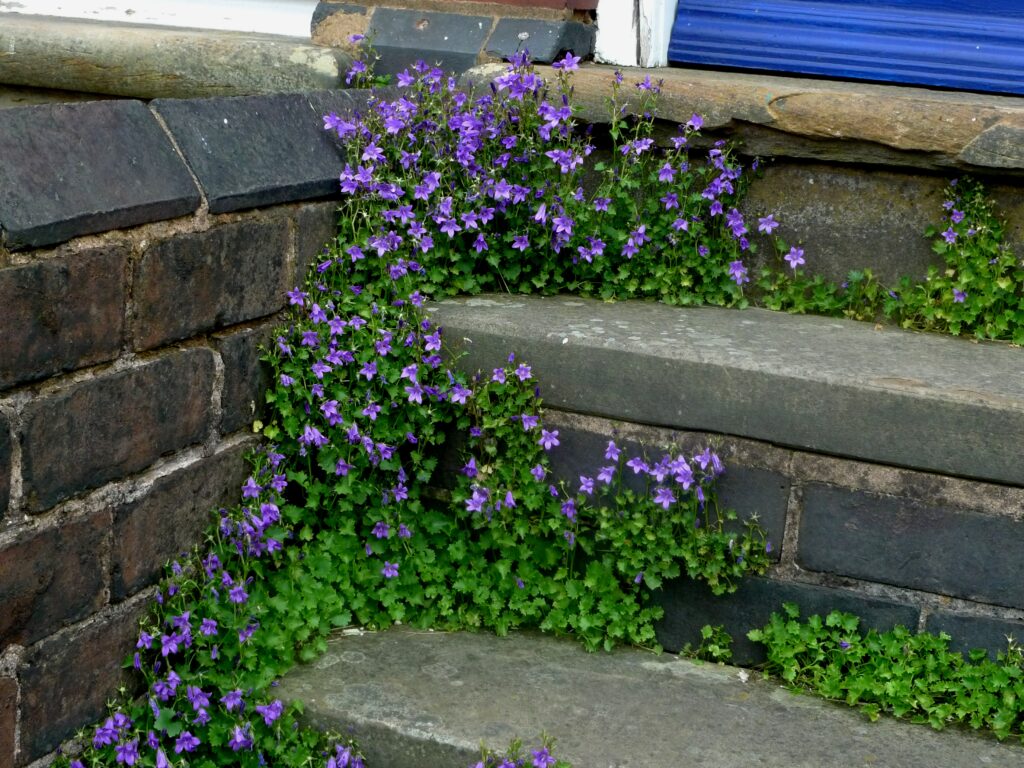
Campanula portenschlagiana or Adria Bellflower
A partially winter-green perennial herb, with subterranean runners, much grown on walls and rockeries in gardens and frequently establishing on the tops and exterior faces of garden walls, as well as in pavement cracks, on rocky banks, and on waste ground. Populations arise from seed and stem fragments, which root readily. It appears less able than C. poscharskyana to self-sow away from human habitations.
Edible Uses (according to Ken Fern from PFAF:
- Leaves can be eaten raw or cooked. The leaves are rather small, but they are produced all year round. They have a mild flavour and make an acceptable ingredient in mixed salads, especially in the winter, but we find that, eaten in quantity, they become a bit unpleasant.
- Flowers can be added in salads and they have a pleasant flavour.
C. poscharskyana
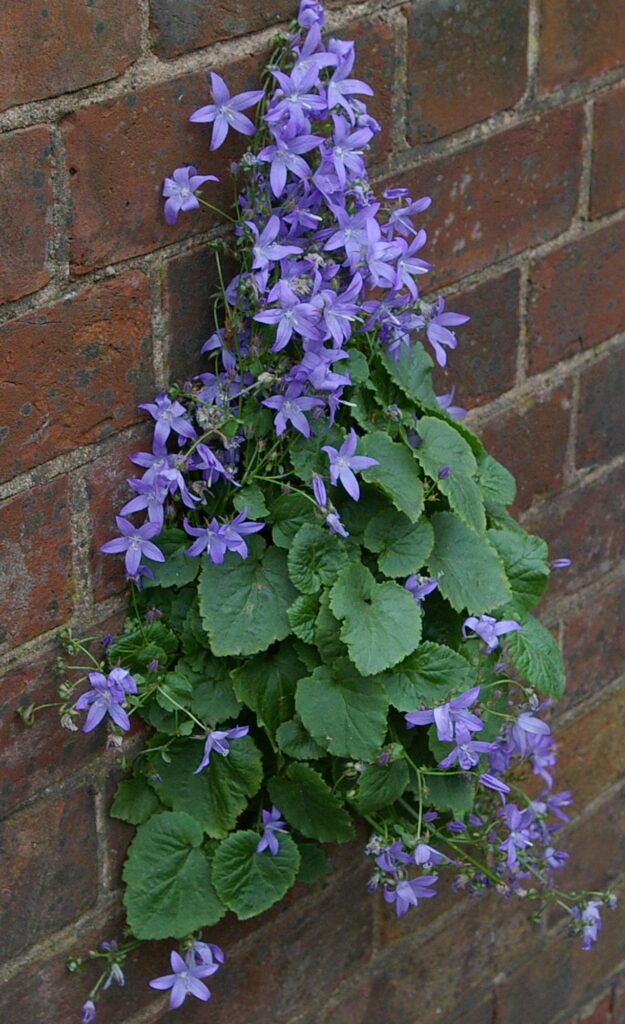
Campanula poscharskyana or Trailing Bellflower
It is similar grown as above species and spreads very rapidly into walls, cracks, etc. It appears to have a greater ability than C. portenschlagiana to self-sow farther away from human habitations.
Numerous varieties and cultivars have been developed for garden use, including ‘Blue Gown’, ‘Blue Waterfall’, ‘Freya’, ‘E.H. Frost’, ‘Glandore’, ‘Lisduggan Variety’, ‘Senior’, and ‘Silberregen’. The cultivar ‘Stella’ has gained the Royal Horticultural Society‘s Award of Garden Merit.
- Leaves may be eaten raw or cooked. Has a pleasant sweet flavour but the leaves are a little tough according to Ken Fern (PFAF). It makes a very good addition mixed in salads during winter
- The flowers taste sweet and make a decorative addition to the salad bowl.
C. latifolia
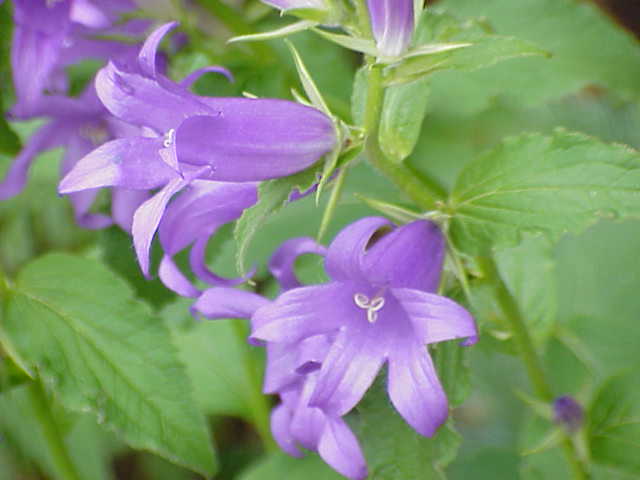
Campanula latifolia or Giant Bellflower
This is a large perennial herb of damp woodland, wooded riversides and hedgerows, usually on fertile, neutral or calcareous soils. It is also grown in gardens, occurring as an established alien on waste ground, roadsides and hedge banks.
It is also grown as an ornamental garden plant.
C. trachelium
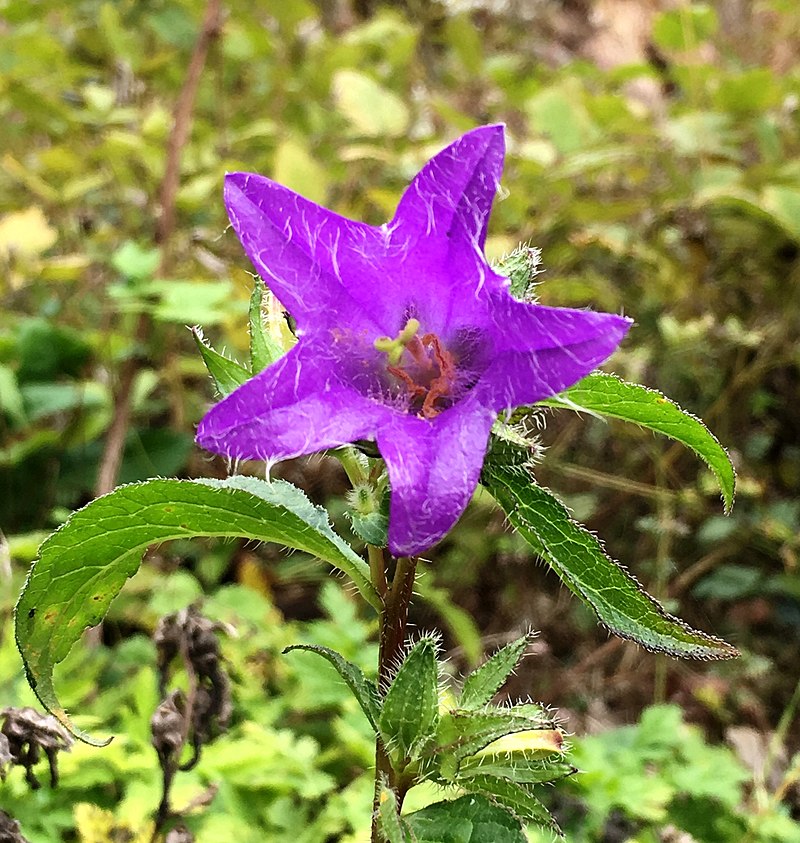
Campanula trachelium or Nettle-leaved Bellflower
A large perennial herb, found as a native on dry, base-rich, usually calcareous soils in woodland, scrubby grassland and hedge banks; in Ireland it is also reported from river banks and swamp woodland. It is also grown in gardens, and occurs as a naturalised alien on a wider range of soils and habitats.
An attractive ornamental plant, which easily spreads by seeds!
This latex-containing plant is used for tonsillitis according to The Medicinal Flora of Britain and Northwestern Europe by J. Barker. A gargle is made from the fresh leaves or roots.
C. rotundifolia
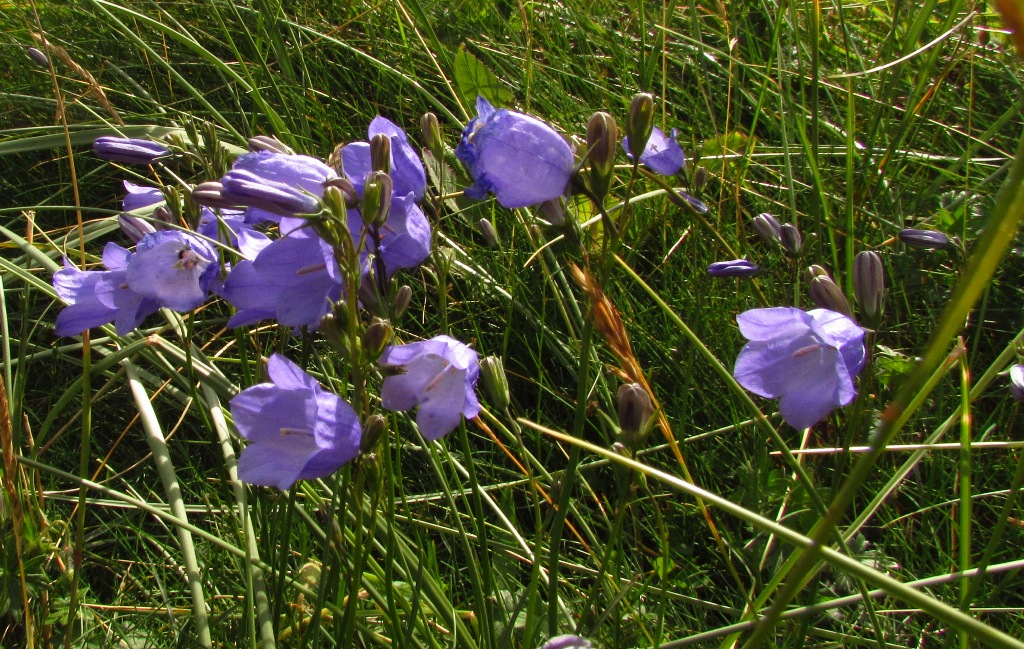
Campanula rotundifolia or Harebell
A rhizomatous perennial herb of dry, open, infertile habitats including grassland, fixed dunes, rock ledges, roadsides and railway banks. It tolerates a wide range of soil pH, being found on both mildly acidic and calcareous substrates, and heavy-metal tolerant races are known.
In Scotland, it is often known simply as Bluebell. It is probably the most common encountered native Campanula on the B.I.
It is regularly visited by bumblebees and Honeybees, providing an autumnal source of nectar for these insects.
According to the charity Plantlife this is the County Flower of Dumfriesshire, Yorkshire and County Antrim!
See also their article about the threat of too much Nitrogen in the air.
The final Campanula added in Stace is:
C. garganica or Adriatic Bellflower
The next genera and species in the Campanulaceae are
Legousia
this genus has only got one Archaeophytal species:
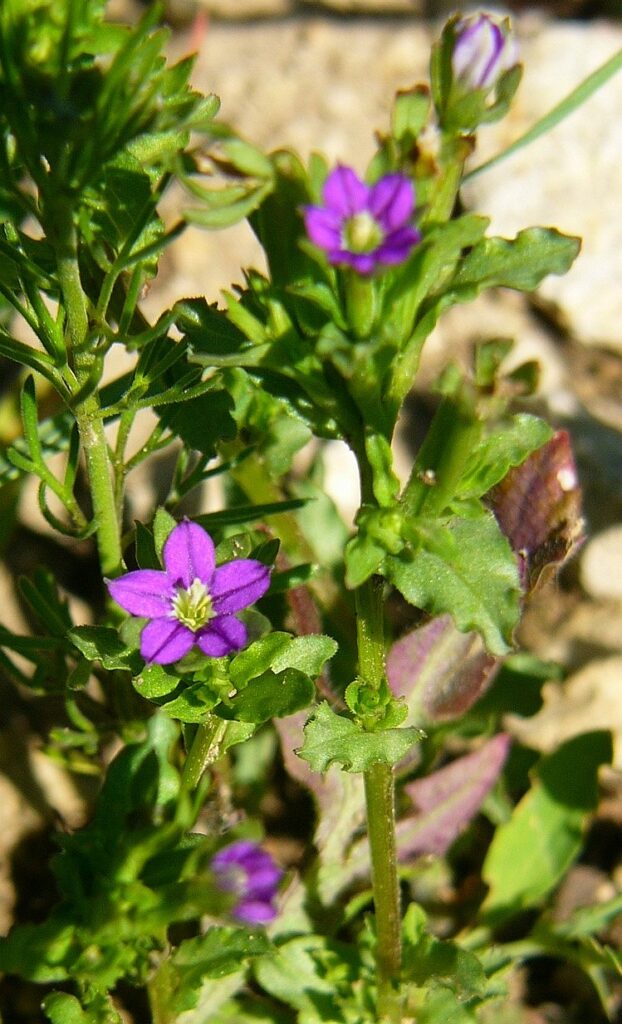
Legousia hybrida or Venus’s-looking-glass
This annual of arable fields is usually found on calcareous soils, especially on chalk. Outside its core areas, it occurs as a casual in disturbed sites such as motorway embankments.
L. hybrida has significantly declined since the 1940s because of the use of herbicides and changing methods of arable cultivation. However, the seed is long-lived and populations can reappear after long periods of absence.
The shining oval fruits which appear inside the seed-capsule give rise to the name, which are said to resemble brilliantly polished brass hand-mirrors.
Wahlenbergia
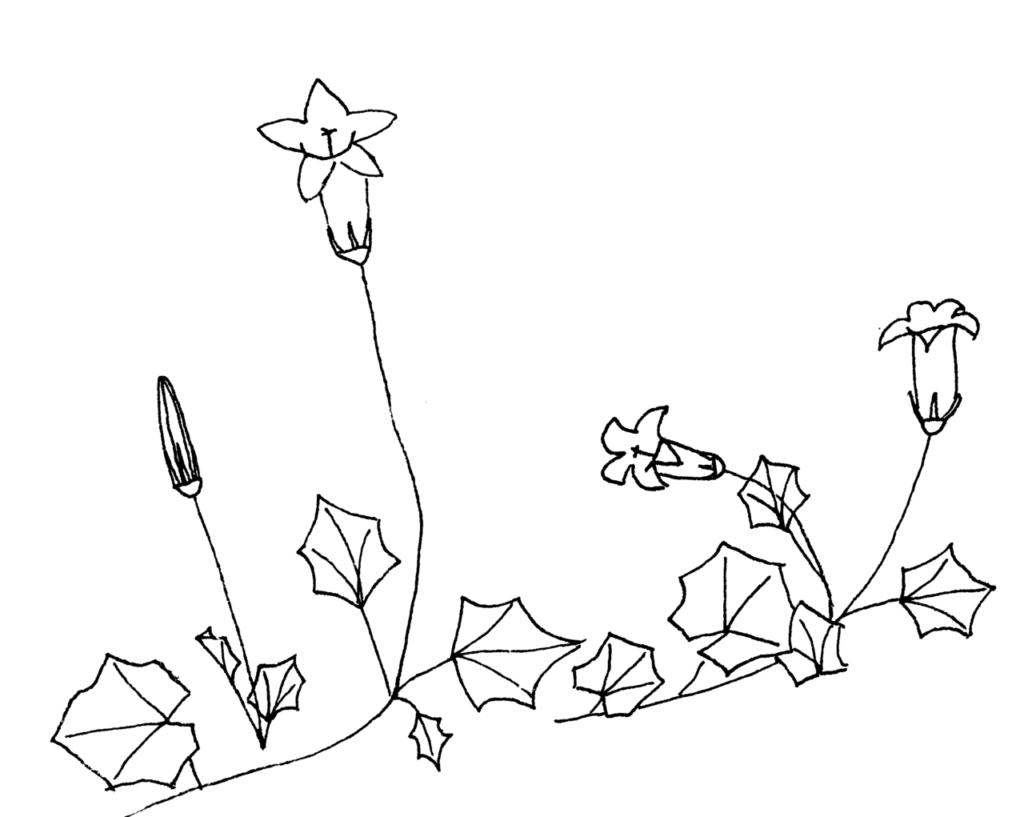
Wahlenbergia hederacea or Ivy-leaved Bellflower
This is a small, low-growing perennial herb found in damp, wet or boggy places on acidic soils, occurring on heaths, heathy pastures, moors, open woodland and Salix carr, and by streams and in flushes. In Ireland, it is most frequent beside streams and is absent from pastures. It prefers areas with moving, rather than standing, water.
Phyteumia or Rampion
Phyteuma spicatum or Spiked Rampion
This is a very rare, attractive wildflower! It is a long-lived perennial herb of damp, fertile, acid soils on road verges, streamsides and in coppiced woodland.
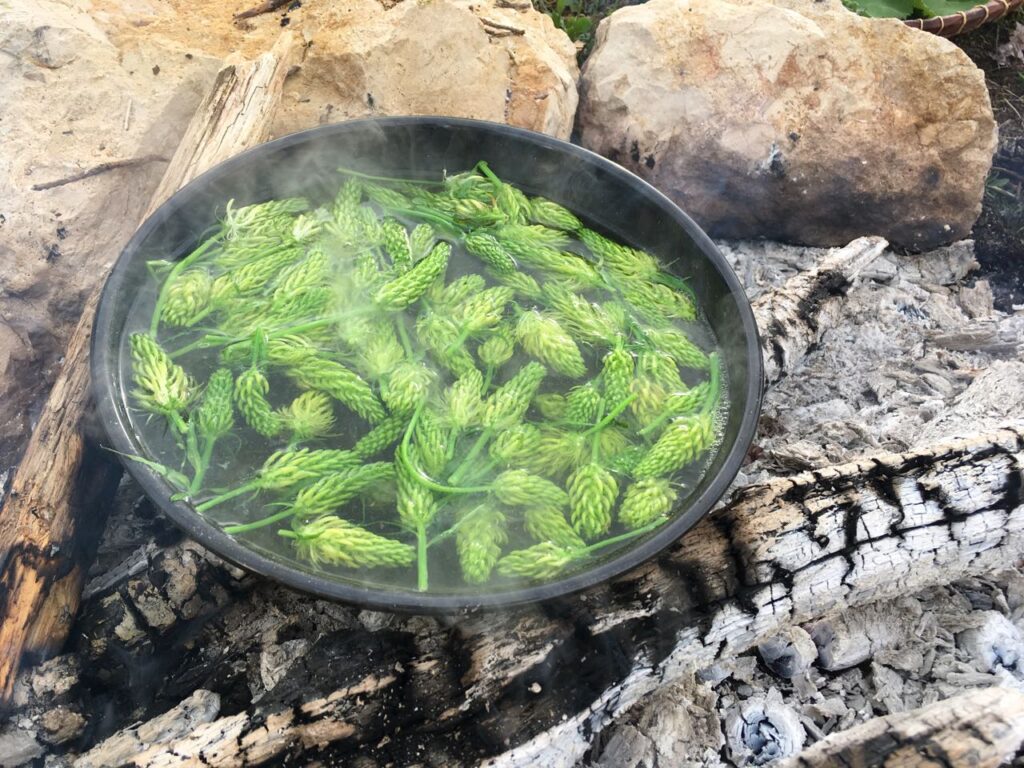
The leaves, roots, and flowers are edible, and can be eaten raw. Flowers before blooming can for instance be prepared by steaming or boiling briefly, then seasoned (see photo above). But I would only do this if it is becoming a real invasive weed though!
This has been grown for centuries as a medicinal plant, and was first recorded in the wild in 1640. Plants in Sussex were first recorded in 1824, suggesting that although traditionally regarded as native, it might be an introduction there.
It was formerly more widespread and more abundant within this stronghold. It cannot tolerate shade and has been lost from a number of sites through a lack of coppicing and the growth of tall vegetation along rides. Over the last decade around 350 plants have been recorded annually across nine sites. It has also been reintroduced to a few sites within this narrow native range.
A detailed report here by Plantlife.
P. orbiculare

Phyteuma orbiculare or Round-headed Rampion is another attractive perennial herb of species-rich chalk grassland, open scrub, earthworks and verges. It is tolerant of grazing, and seems to prefer grazed areas, but also grows in neighbouring ungrazed grassland. Propagation is mostly by seed but it also spreads by stoloniferous growth.
The round-headed rampion is known colloquially in the county of Sussex, England as the Pride of Sussex. It is also the County flower of Sussex. As Sussex’s county flower, its name was chosen for the Rampion Wind Farm, a wind farm off the coast of Sussex.
Jasione or Sheep’s-bit
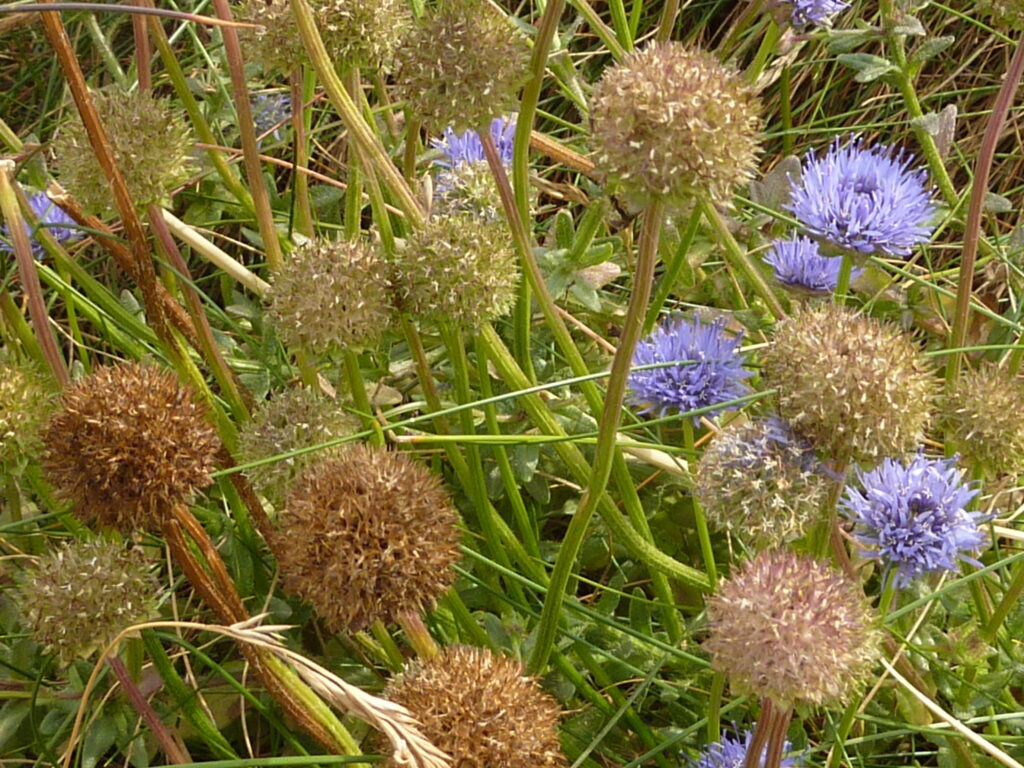
Jasione montana or Sheep’s-bit is a biennial herb of acidic, shallow, well-drained soils. It occurs on sea-cliffs, in maritime grasslands and heaths and on stabilised sand dunes, and inland on heathland, stone walls, hedge banks and railway cuttings. Propagation is by seed and disturbed, open sites and recently burnt ground are frequently colonised.
Some fifty species of bees and wasps, thirty species of fly, thirty species of butterflies and moths and several beetles have been recorded as visiting the flowers, and therefore this plant is characterized by a generalized pollination syndrome.
The flowers are visible under ultraviolet light and it is believed that this makes them attractive to pollinating insects. They do not show a traditional bull’s-eye pattern to guide the insect but the ultraviolet reflectance of the petals is very high.
Lobelia
There are 2 native species according to Stace:
L. urens
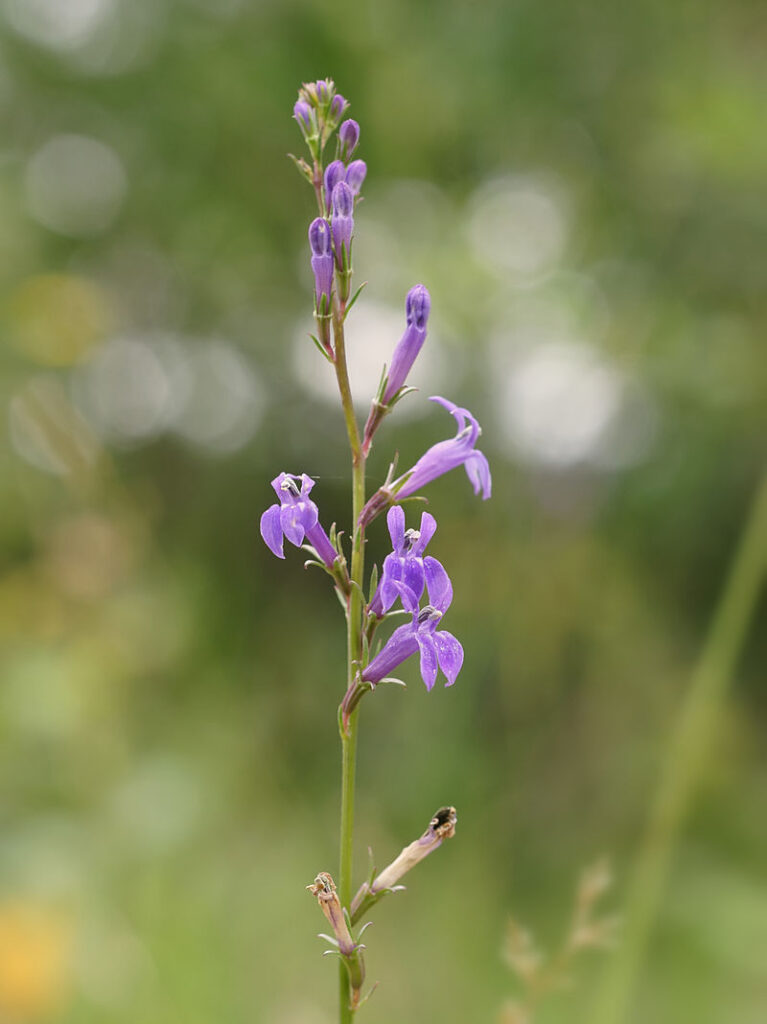
Lobelia urens or Heath Lobelia
A rhizomatous perennial herb of rough pastures and grassy heaths dominated by Molinia caerulea. It is confined to infertile moderately acidic soils that are often seasonally waterlogged. Reproduction is by seed, which may be long-lived, and germination seems to be stimulated by disturbance. Most populations fluctuate erratically in size. It is rare in Britain and only found in South and South West of England in lowland areas up to 210 metres high.
L. dortmanna
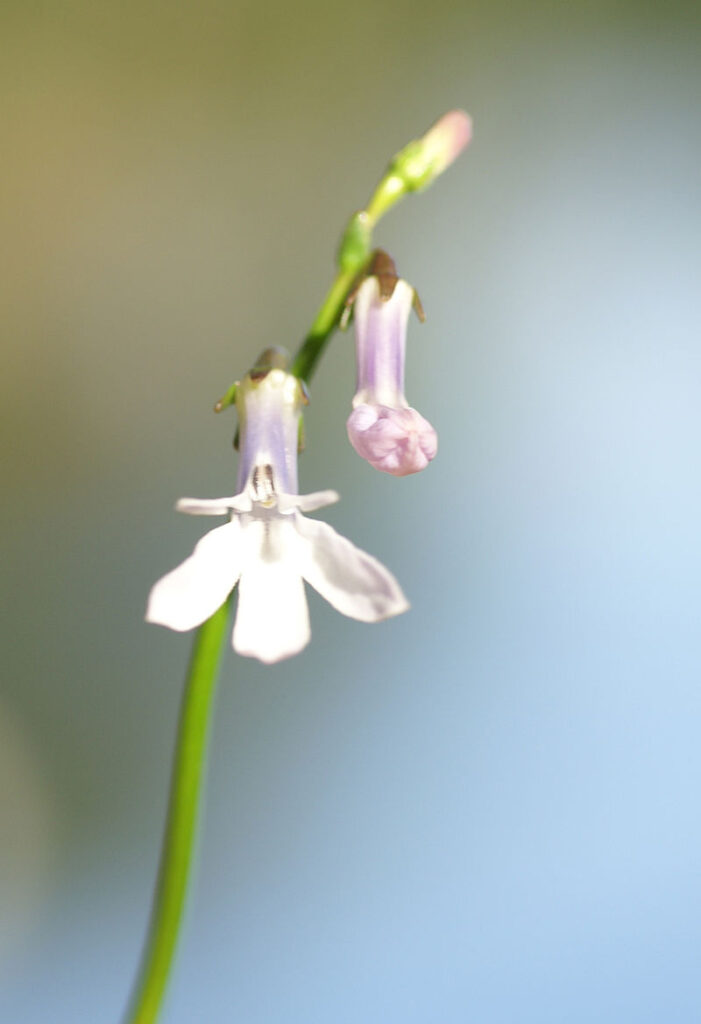
Lobelia dortmanna or Water Lobelia is a small, rosette-forming perennial herb of oligotrophic lakes with acidic substrates. It is slow-growing, with little ability to withstand shade or competition and is therefore confined to shallow water less than 2 metres deep. It is still frequent in the north and west but has declined, largely before 1930, from the eastern edge of its range in both Britain and Ireland through eutrophication.
Pratia
Pratia angulata or Lawn Lobelia is a small, patch-forming procumbent herb with stems that root at the nodes, found naturalized on damp lawns, mainly in parks and botanic gardens.
It is an introduces species from New Zealand. Grown as an ornamental creeping plant. See here for Pratia angulata ‘Treadwellii’.
and last of all:
P. pedunculata
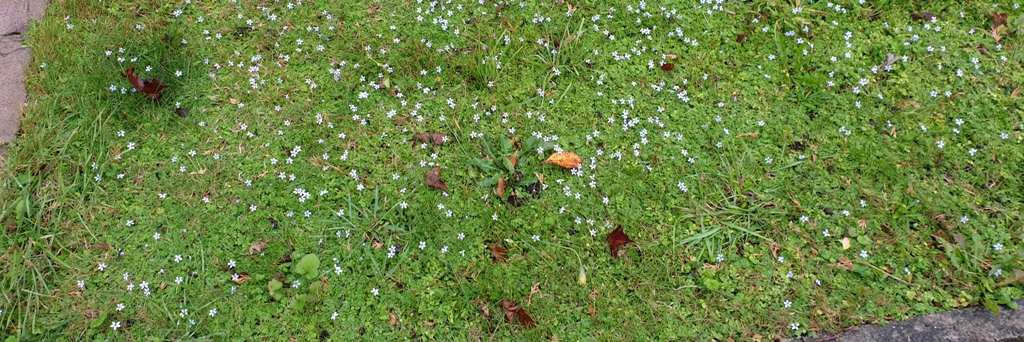
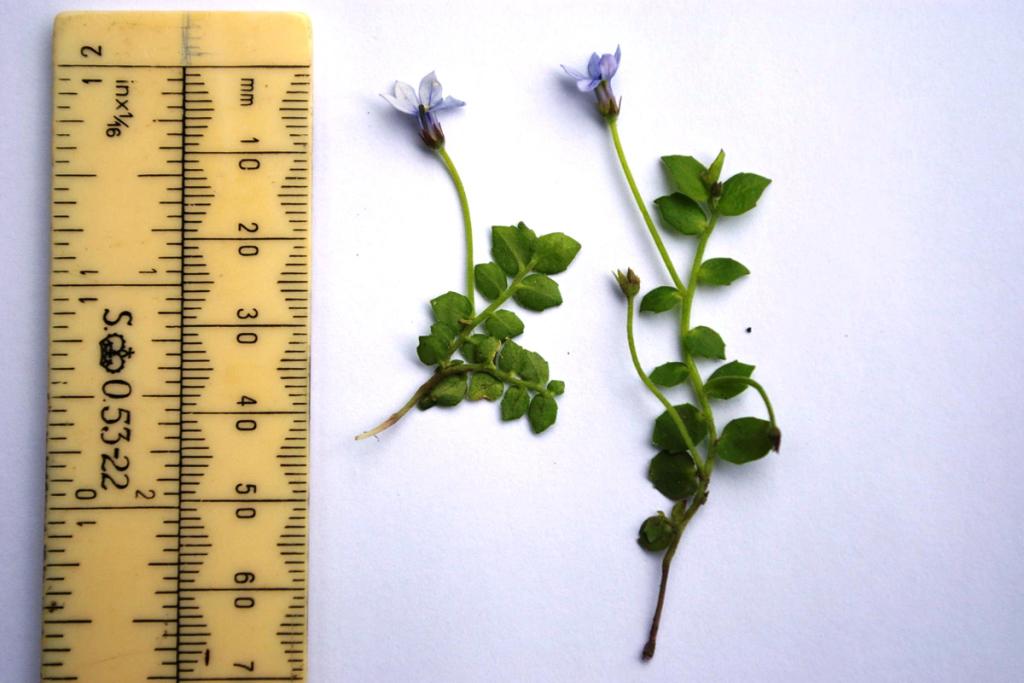
Pratia pedunculata or Blue Star Creeper is similar as above, grown as an ornamental and not mentioned by Stace, but clearly it has been noticed in our native region!

